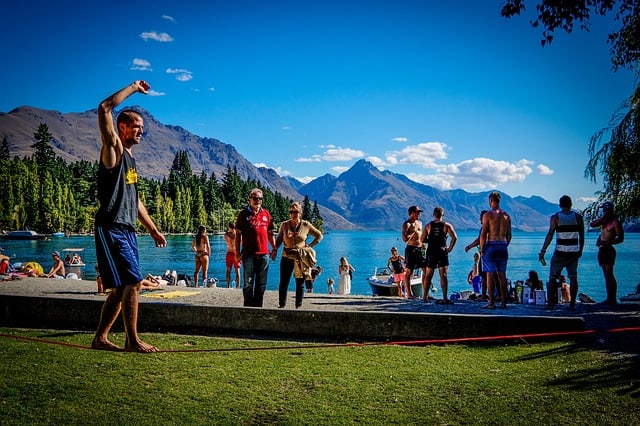Many pictures you see of slackliners show people doing it with no shoes on. You might ask yourself why do you slackline barefoot and wouldn’t wearing shoes be a better choice?
The truth is you don’t have to slackline barefoot but you can if you like. You can also wear flat-soled athletic shoes and there are advantages and disadvantages to each option.
Some experienced slackliners go barefoot because they like that their feet are directly on the slackline and can feel the contour of the line, just like a gymnast does on a balance beam. Others prefer to wear shoes that protect the feet and also provide ankle support if you fall to the ground.
This is especially true if the ground is dirty or has sharp objects. It’s up to you which option you choose.
Slacklining Barefoot

Pros
- Gives you the sensation of your feet directly on the slackline which may give more feel and control.
- Toes can grab the line to a degree for better grip when you’re barefoot.
- Good choice when you’re slacklining at a beach or over another soft, clean ground where foot protection may not be needed.
- Often preferred by experienced slackliners who feel comfortable with their skills and ability to stay on the line.
Slacklining With Shoes

Pros
- Protects feet and toes if you fall especially if you are slacklining over ground that is uneven or rough or that has sharp objects.
- Strong athletic shoes with a flat bottom offers protection from rolling your ankles especially if you’re a beginner.
- Athletic shoes can be thin enough that you still get the feeling of being barefoot with the protection of having shoes.
- Tends to be beneficial for trickliners.
Slacklining in the snow
Some people have taken to slacklining in the snow during winter. Clearly footwear of some kind is required for this activity but what kind? Winter boots are big and clunky and aren’t conducive to success when trying to balance on a 1″ or 2″ wide slackline.
When slacklining in the snow or during winter when it’s cold, your best bet is to first put something warm and protective on the ground over where you’ll be slacklining. Perhaps a blanket or waterproof tarp that protects your feet from the ground. If you have snow on the ground, it’s best to put something waterproof as you may have the option of going barefoot if it’s not too terribly cold or using your regular slacklining shoes if needed.
Conclusion
Slacklining can be done with or without shoes and it tends to be a personal choice. A decent pair of athletic shoes may also offer support to prevent ankle rolling or other foot injury.
Slacklining barefoot on the other hand gives you the feeling of your feet directly on the slackline which gives some people a better feel while they’re walking. If you’re slacklining at a beach with sand, foot protection may not be as necessary when slacklining over a rough ground with debris.
Recent Posts
Slacklining is a challenging activity that involves walking, balancing, and performing tricks on a flat piece of webbing stretched between two anchor points. It has become increasingly popular in...
Slacklining is a fun and challenging way to improve your balance, core strength, and overall fitness. Whether you're new to slacklining or a seasoned pro, incorporating a slackline workout routine...


